Subsequently, the "Ensemble" sandbox will further research and test tokenization use cases, including the settlement of tokenized real-world assets (such as green bonds, voluntary emission reductions, aircraft, electric vehicle charging stations, electronic bills of lading, and treasury management), and is more likely to develop into new financial market infrastructure, serving as a bridge between tokenized real-world assets and tokenized currencies.
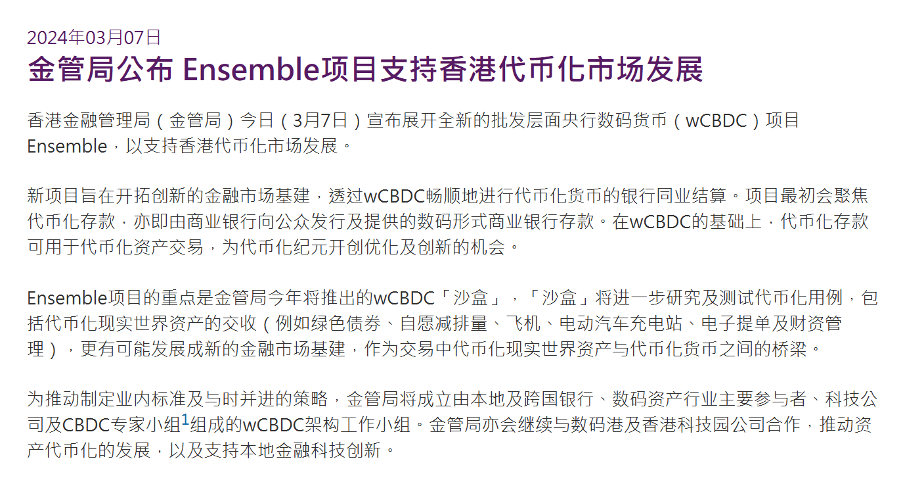
In fact, the Hong Kong government and financial regulatory authorities have been relaxing policies for the digital asset industry for years and promoting innovative development of the industry, and the emergence of the "Ensemble" project is a digital asset financial experimentation platform built by Hong Kong against this backdrop, which not only helps Hong Kong establish a compliance-oriented testing system, but also provides an opportunity to test the waters for future digital asset innovation business.
It is well known that RWA tokenization refers to the tokenization of physical assets (such as bonds, gold, real estate and other commodities) into digital assets on the blockchain, thereby bringing some exclusive advantages that on-chain native assets and traditional financial assets cannot match:
● Improved cost-effectiveness: First, tokenization eliminates the need for intermediary brokers, significantly reducing transaction costs and improving efficiency;
● Better accessibility: Secondly, tokenization allows traditional assets to be divided into smaller fractions, thereby improving accessibility and liquidity;
This means that RWA can become the main driving force for the incremental growth of on-chain digital assets, enabling Web3 to effectively reach the vast asset pool of the traditional market, such as the global bond market ($133 trillion) and the gold market ($13.5 trillion) - within the framework of tokenization, these physical assets can not only enter the on-chain trading ecosystem, but also obtain DeFi yields through lending and pledging, introducing real yield assets to support the digital asset market and enhancing its value foundation.
You should know that since the financial innovations of protocols like Compound in 2020 ignited the DeFi boom, the digital asset volume has seen tremendous growth, reaching a total value locked (TVL) of $88 billion as of October 25, 2024. But compared to the tokenizable RWA assets (bonds, gold, stocks, real estate, etc.) that can easily reach tens of trillions of dollars, this volume is still negligible, and the tokenization of RWA may bring strong incremental momentum to the on-chain assets.
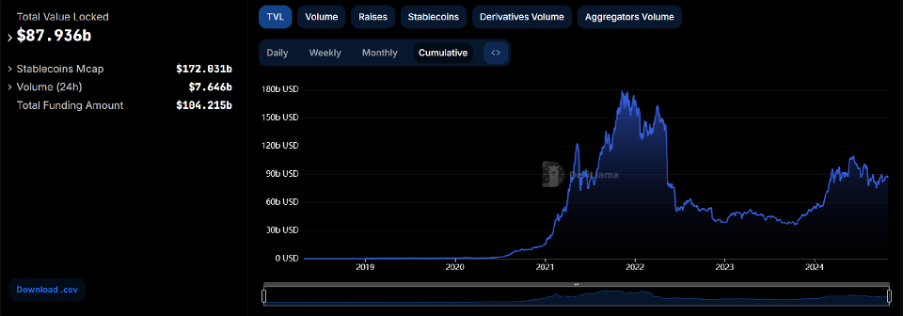
It can be foreseen that with the gradual popularization of RWA tokenization, the on-chain world will undergo deeper transformation, the boundary between traditional finance and digital finance will become increasingly blurred, and the on-chain asset system will not only expand significantly in scale, but also achieve breakthroughs in compliance and transparency, bringing more diversified choices for global investors.
This is also the significance of the "Ensemble" project: by building a highly innovative testing platform, Hong Kong is conducting forward-looking exploration for the deep integration of the digital asset financial ecosystem, and its new products and new models will become a "rehearsal" for the next stage of digital asset innovation in Hong Kong, providing strong momentum for Hong Kong to become a global RWA tokenization hub.
And the collaboration between OSL, Huaxia Fund and Franklin Templeton is precisely to jointly promote the integration of traditional finance and digital asset finance, enhancing the compliance and transparency of the on-chain, and laying a solid foundation for the future expansion of the digital asset market.
RWA Tokenization, the Crypto Era Train that Hong Kong Cannot Miss?
Hong Kong's demand for RWA tokenization stems from its deep financial culture background as an international financial center. First, RWA tokenization provides a new opportunity for the integration of digital assets and traditional finance, allowing funds, bonds, equities and other assets to be tokenized through blockchain technology and digital assets, thereby improving the liquidity and accessibility of the assets.
At the same time, the huge and mature asset targets and scale required by the RWA market are also the comfort zone of Hong Kong as an international financial giant - with a rich financial service industry, years of accumulation and rich experience, a mature risk control system, a sound trading infrastructure and a large customer base.
Therefore, these advantages can help Hong Kong quickly put RWA assets on-chain, providing the market with compliant and secure trading solutions, and becoming a bridge between Web2 and Web3.
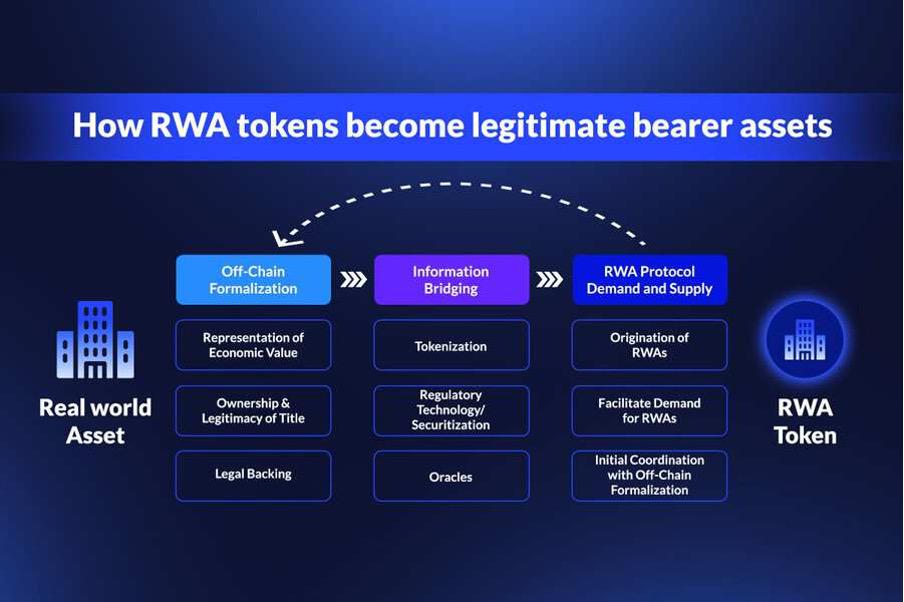
In other words, the connection between on-chain and real-world assets is also the solution that is extremely lacking and in demand for the integration of digital asset finance and traditional finance. For this reason, under the framework of the "Ensemble" project, Hong Kong has set up four key themes for the experimental testing of RWA tokenization - fixed income, investment funds, securitization and trade finance, among which fixed income and investment funds are seen as the initial experimental focus of RWA tokenization.
For example, OSL's collaboration with Franklin Templeton in the Ensemble project to conduct a proof-of-concept for a tokenized fund product, as a frontier representative of this exploration, is expected to promote the on-chain and transparent transformation of fixed income products, bringing innovative changes to the asset management field:
● Compliance and security: OSL, relying on the compliance testing platform of the Hong Kong Monetary Authority, ensures that the tokenized fund meets regulatory standards, providing a safe and reliable investment channel for global investors;
● Improved liquidity and transparency: Tokenization allows the fund product to be transparently traded on the blockchain, with the assets being divisible into smaller fractions, increasing liquidity and allowing investors to enjoy the liquidity and transparency advantages of the decentralized market;
● Improved efficiency and cost optimization: Tokenization simplifies the traditional fund management process, reducing intermediate costs, making the fund product more inclusive and attracting a wider retail investor base;
In short, the tokenized investment fund product collaboration between OSL and Franklin Templeton is theoretically able to significantly improve settlement speed and efficiency, and by allowing small-scale investment, it can lower the entry threshold, bringing new liquidity sources to the market, and is expected to further promote the development and popularization of the RWA market.
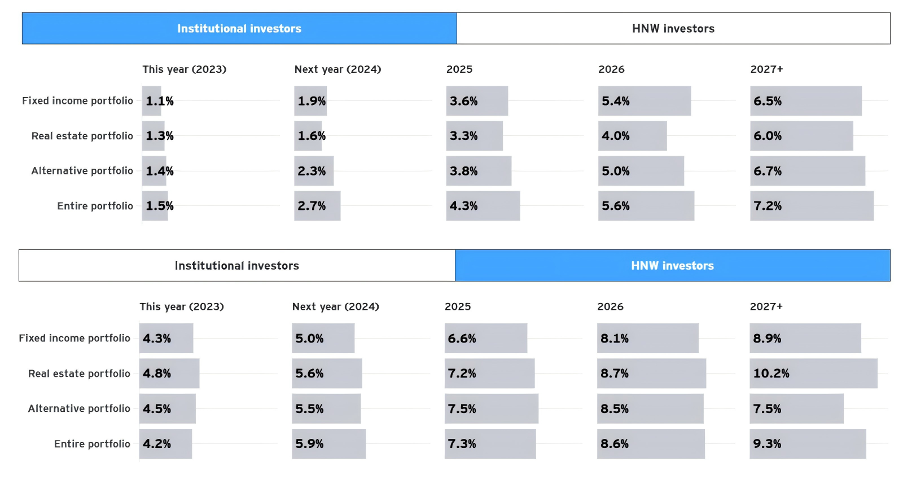
In the future, RWA tokenization represented by investment fund products will bring new sources of liquidity to the Hong Kong market, promoting its global popularization:
According to EY's forecast, by 2026, institutional and high-net-worth investors are expected to allocate 5.6% and 8.6% of their portfolios to tokenized assets, which also means that within the next 3 years from this year, the incremental growth in the allocation of institutional and high-net-worth investors to RWA tokenization investments will generally exceed 100%.
Retail-oriented products may be the ignition point for RWA?
What has been the most successful digital asset financial product globally in the past 5 years?
The answer is not hard to guess, it is neither the on-chain financial innovations that ignited the DeFi Summer like Uniswap, nor the digital art pieces that sparked the NFT craze like CryptoPunks, but rather the stablecoins that we have long been accustomed to.
This stablecoin with RWA properties, aimed at the general user, has become one of the widely accepted use cases of digital assets - the on-chain account number of the USDT TRC20 version alone exceeds 40 million, truly achieving the popularization of blockchain and greatly expanding and deepening the user base of Web3 and digital assets.
Major TradFi institutions such as BlackRock, Citibank, Franklin Templeton and JPMorgan Chase have also focused on such products, with the aim of further expanding the application of digital assets in everyday financial life. Currently, the circulating tokenized government bond fund led by the Franklin on-chain US Government Money Market Fund (FOBXX) and the BlackRock US Dollar Institutional Digital Liquidity Fund (BUIDL) has a scale of nearly $1 billion, laying a solid foundation for the application of RWA tokenization products in the retail market.
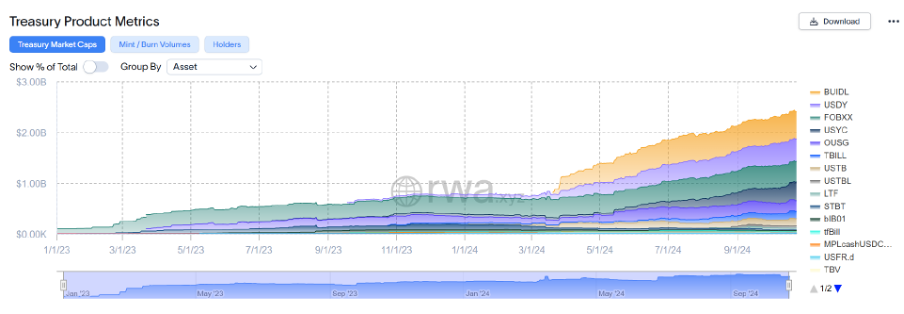
Objectively speaking, retail-oriented RWA tokenization products have the advantage of inclusiveness in attracting more ordinary investors to participate: in the past, ordinary investors had to face relatively high capital thresholds and complex transaction processes to participate in the traditional financial market of US Treasuries, real estate or high-end stocks, but now through RWA tokenization, these assets can be divided into smaller trading units, greatly reducing the investment threshold.
More importantly, retail-oriented RWA products enhance risk control capabilities through the transparency of blockchain, bringing higher trust to investors, promoting the further application and popularization of digital assets in everyday financial life, and there are a group of digital asset companies in Hong Kong pushing for compliant RWA innovation and promotion.
Among them, OSL, as Hong Kong's first licensed virtual asset platform, has played a key role in this process, especially being well aware of the strategic significance of retail-oriented RWA products for Hong Kong's digital asset ecosystem, and therefore actively committed to introducing tokenized assets into the mass market, including leveraging its policy advantages as a compliant platform to expand partnerships with traditional financial institutions to provide compliant RWA trading services for customers.
● Hong Kong's first licensed platform with rich experience: As the first platform in Hong Kong to be granted a virtual asset license, OSL has over six years of rich experience in the digital asset industry;
● Extensive cooperation with top traditional financial institutions: OSL has established a solid partnership with financial institutions such as UBS, Huaxia Fund, Jiashi Fund, and Franklin Templeton to jointly promote projects such as digital asset ETFs and investment fund tokenization;
● Compliance assurance and insurance coverage: OSL follows strict regulatory requirements, providing a compliant and secure cooperation environment for financial institution partners, and has obtained the world's largest $1 billion insurance coverage, becoming the single digital asset custodian with the highest and longest insurance coverage;
● Full product line and comprehensive service licenses: OSL started from the over-the-counter trading business in Hong Kong, and has now obtained a complete license to provide tokenization project services, covering the issuance, custody, trading services, asset distribution and blockchain technology services of digital securities.
It should be noted that in terms of business model, RWA covers multiple levels from the underlying infrastructure to the upper DeFi, and institutions like OSL can not only provide underlying infrastructure services, responsible for tokenizing and custodizing physical assets on-chain; but also engage in the middle-layer business, introducing asset returns into the DeFi field to provide investors with more earning opportunities.
Overall, OSL's layout not only helps Hong Kong strengthen the connection between Web3 and traditional finance, but also brings higher trust and a more convenient participation experience for investors through compliant asset management and risk control.
Conclusion
For the exploration of Hong Kong's digital asset finance, RWA tokenization is indeed an "paradigm shift" worth looking forward to. If a way can be found to legally combine on-chain digital assets and real-world assets, and be promoted in a retail form by institutions like OSL and Huaxia Fund, it may well be the next "ignition point" for digital asset finance.
From this perspective, the role played by OSL also highlights Hong Kong's advantages in global digital asset financial innovation - as one of the oldest virtual asset companies in the world, OSL has deep digital asset expertise, and this professionalism provides a guarantee for the compliance and transparency of RWA tokenization projects, which is precisely Hong Kong's natural advantage as an international financial center:
As an international financial center, Hong Kong has abundant traditional financial resources, whether it is a mature risk control system, a sound trading infrastructure or a large customer base, all of which support the introduction of RWA such as funds, stocks, and gold into the chain, fully releasing their liquidity.
At the moment, we have confidence in looking forward to its early arrival.
Disclaimer: As a blockchain information platform, the articles published on this site only represent the personal views of the authors and guests, and are not related to the position of Web3Caff. The information in the articles is for reference only and does not constitute any investment advice or offer, and please abide by the relevant laws and regulations of your country or region.
Welcome to join the official Web3Caff community: X(Twitter) account | WeChat reader group | WeChat public account | Telegram subscription group | Telegram discussion group








